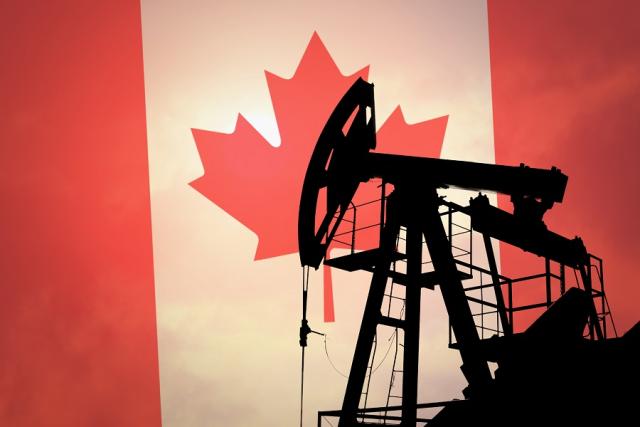
Wood Mackenzie expects Canada’s largest natural gas producers — Tourmaline Oil, Canadian Natural Resources (CNRL) and ARC Resources — to continue to grow their unconventional production in 2023 despite inflation pressures. (Source: Shutterstock.com)
Canadian oil and gas producers will boost capex in 2023 but average production growth isn’t likely to exceed the single-digit percentage range, according to Wood Mackenzie.
“The largest Canadian gas producers will continue to grow unconventional production next year, but will also experience the highest cost inflation pressure,” the firm wrote in its December 2022 Canada upstream report.
The top three Canadian E&Ps, each with a presence in the Montney Shale, plan to boost capex and production to varying degrees. Tourmaline Oil is expected to boost capex by about 9% while production grows 40,000 boe/d, or 8%. Canadian Natural Resources (CNRL) expects to increase capex 18% with resulting production growth of 6%. And ARC Resources will spend 40% more with just 2% more production, Wood Mackenzie said.
Canada’s oil and natural gas industry is active in 12 of 13 provinces and territories, the Canadian Association of Petroleum Producers (CAPP) said on its website. Canada is the world’s fourth-largest oil producer and sixth-largest gas producer. Canada’s gas production is destined for domestic and U.S. markets and in the future will feed LNG export projects on both sides of the border between the two North American countries.
Top three gas producers lead the pack
Tourmaline: Canada’s largest gas producer and the country’s fourth largest gas processing midstream operator is eyeing capex of CA$1.9 billion in 2023 and production between 520,000 boe/d to 540,000 boe/d, the company said in a January corporate presentation.
“Tourmaline’s scale in Canada’s premium gas plays, production base and low-cost infrastructure provide investors a suite of advantages with efficiency, profitability, growth and return on (and of) capital unparalleled by peers,” Tourmaline said. The company’s inventory ownership provides multiple decades of development with no need to seek expensive resource additions, it said.
CNRL: Canada’s second-largest gas producer and the country’s largest oil producer is eying capex of CA$5.2 billion in 2023, the company said November in a press release. CNRL’s long-life, low-decline assets offer sustainable production and free cash flow in a low-price environment and the ability to ramp up production with improving prices, according to the company.
CNRL is eyeing year-over-year production growth of 56,000 boe/d based on the midpoint of its production guidance range of 1.33 MMboe/d to 1.374 MMboe/d for 2023, the company said.
ARC: Canada’s No. 3 gas producer and the country’s largest condensate producer is eyeing capex of CA$1.8 billion in 2023 with approximately 70% allocated to Alberta and 30% to British Columbia, the company announced in December in a corporate presentation. “The capital program balances profitable growth with the flexibility to increase capital returns to shareholders as net debt is reduced,” ARC said.
ARC is expected to produce average production of between 345,000 boe/d to 350,000 boe/d (60% gas and 40% oil and liquids) in 2023 and includes infrastructure investment to lower operating costs at Kakwa, its largest producing asset, according to the company.
Oil sands capex
In 2023, capex destined for sustaining oil sands activities is also expected to rise but at a lower rate, according to Wood Mackenzie.
Whitecap Resources is forecasting production growth after its acquisition of ExxonMobil’s Montney and Duvernay acreage. Cenovus Energy is forecasting a 130% rise in capex while also upping oil sands production 60%, according to Wood Mackenzie. “But adjusting for recent acquisitions, no company is looking to grow production beyond single digits. The only exception are companies leading in the fast expanding Clearwater play,” the consultancy said.
In the Clearwater heavy oil play, production exceeded 100,000 bbl/d in 2022. There, Tamarack Valley Energy looks to retain its spot as the play’s top operator, while jockeying with Spur Petroleum for top status. Headwater Exploration, which bought Cenovus’ position in the play, forecasts growth of 38% with production guidance of 18,000 bbl/d in 2023, according to Wood Mackenzie.
Recommended Reading
Dividends Declared Week of Nov. 4
2024-11-08 - Here is a compilation of dividends declared from select upstream and midstream companies in the week of Nov. 4.
TC Energy Appoints Two Independent Directors to Board
2024-11-07 - TC Energy Corp. appointed Independent Directors Scott Bonham and Dawn Madahbee Leach to its board, the company announced Nov. 7 in a press release.
OMS Energy Files for IPO, Reports Revenue Growth
2024-11-06 - Singapore-based OMS Energy, a wellhead system manufacturer, has not yet determined its price range and number of shares.
Record NGL Volumes Earn Targa $1.07B in Profits in 3Q
2024-11-06 - Targa Resources reported record NGL transportation and fractionation volumes in the Permian Basin, where associated natural gas production continues to rise.
Twenty Years Ago, Range Jumpstarted the Marcellus Boom
2024-11-06 - Range Resources launched the Appalachia shale rush, and rising domestic power and LNG demand can trigger it to boom again.
Comments
Add new comment
This conversation is moderated according to Hart Energy community rules. Please read the rules before joining the discussion. If you’re experiencing any technical problems, please contact our customer care team.






